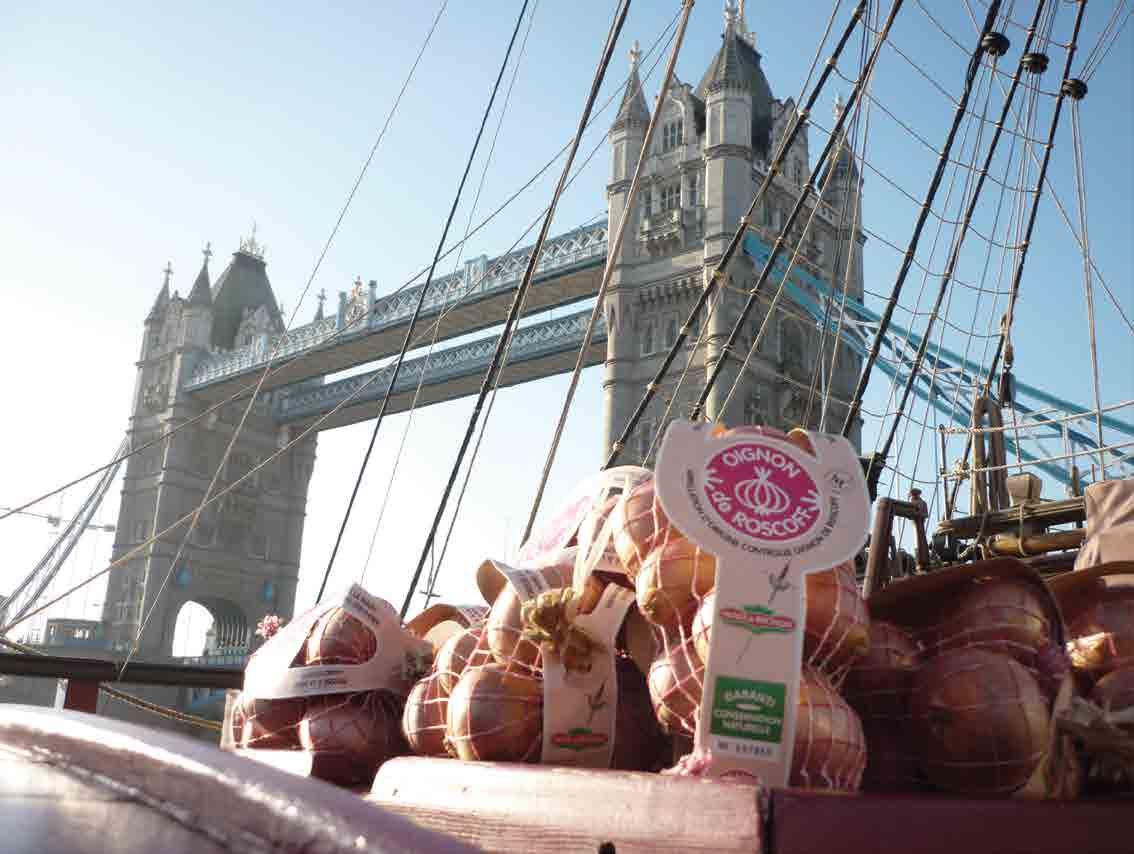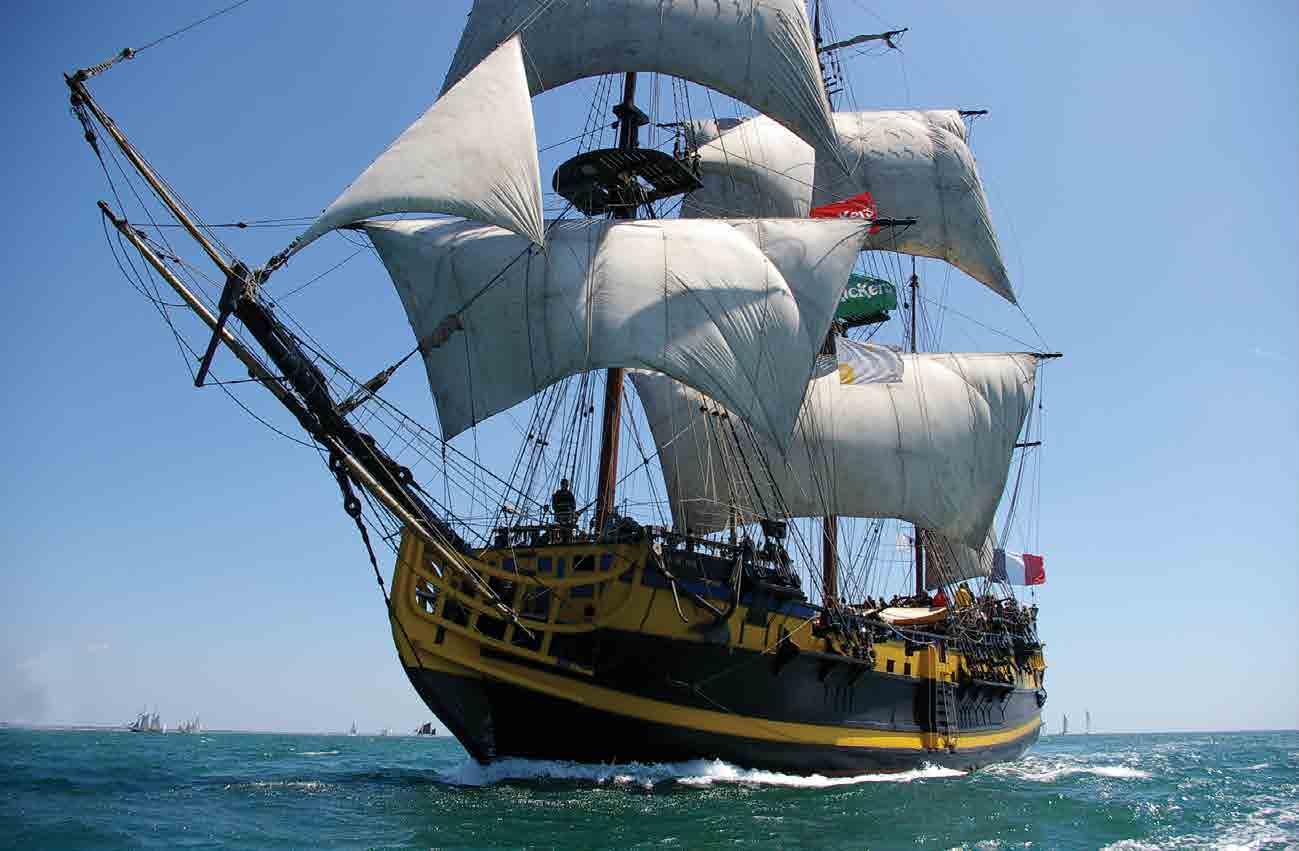
4 minute read
Prince of onions Breton onions come to Britain
PRINCE OF ONIONS

This December British trade professionals and the public were invited to discover the delights of Roscoff pink onions from Brittany. Peter Mercer went aboard.
IN 1828 a young farmer from Roscoff, on the northern coast of Brittany, decided that it was about time the English had a taste of a proper onion. He was so successful in selling his distinctive pink Brittany onions over there that soon French onion sellers, or Johnnies, as the English called them, were familiar sights throughout southern England, carrying their plaited onions from door to door on their shoulders or draped across their bicycles. Even if they didn’t all wear striped jerseys and berets, they became, for the English, an iconic image of the typical Frenchman. By the 1860s Roscoff had become the market gardening capital of western France and hundreds of boats carrying onions and artichokes left its port for England every year. In 1929 more than 9000 tonnes of Brittany onions were sold in the UK by almost 1400 Johnnies, whose bicycles were to be seen as far north as Glasgow.
Today around 20 Breton producers still travel from door to door across the UK but, of course, the technology of produce transportation has changed a bit – now the pink onions travel daily across the Channel by Brittany Ferries. Although not always. At the end of November, 4.5 tonnes of Prince de Bretagne pink onions were hand loaded by 200 people on to a 300-tonne, 20-gun frigate, which then slipped out of Roscoff harbour and set sail for England. The vessel was moored in London, at St Katherine’s Docks, near Tower Bridge, for ten days in early December – her fully rigged three masts standing out among the usual luxury motor yachts.

Of course, it doesn’t take that long to unload 4.5 tonnes of onions. The Etoile du Roy was actually in London to promote the Prince to Bretagne brand of onions, shallots and garlic to the trade, the media and to the public. And, of course, the ship is not actually an eighteenth century warship but a replica of the privateer Grand Turk, which was seized by the Royal Navy in 1746. Today’s 47-metre vessel was built originally for the British TV series ‘Hornblower’ and is now operated out of Saint Malo, where the original ship was constructed in 1745, by the French cruise company Etoile Marine.
Collective strength
The voyage of the Etoile du Roy was supported by the Breton farmers cooperative SICA (Societe d’Initiatives et de Cooperation Agricole) and the Prince de Bretagne brand. Founded in 1961, SICA is today the largest gathering of fresh produce farmers and horticulturists in France. It includes 1500 producers based in Saint-Pol de-Leon – the area to the south of Roscoff – who together harvest 300,000 tonnes of fruit and vegetables under the Prince de Bretagne brand as well as seven million plants under the Kerisnel brand. All the members of SICA are responsible for their own farms but share a culture of attachment to traditional quality and local production methods as well as working together on continual innovation in R&D, production techniques and marketing.
Prince de Bretagne is the collective brand for the fruit and vegetable producers of northern Brittany. Established in 1970, it is used by 2500 growers from six Breton cooperatives, including SICA, who today produce more than 600,000 tonnes of fresh vegetables each year. Production includes more than 40 types of vegetable, from onions and garlic to artichokes, cauliflowers, leeks and lettuces, grown in some 40,000 hectares of land. Most Prince de Bretagne vegetables are harvested manually and packed directly in the field before being shipped to more than 30 countries.
Prince de Bretagne was created to give Brittany producers the advantages of a strong brand image that would be identified with the highest quality and which would be recognised throughout the supply chain, right through to consumers. Of course, they already had the advantage of Brittany’s exceptional growing conditions – the region’s temperate oceanic climate means that frosts are rare in winter and summer is seldom too hot. Up to 15km inland from the sea, the sunshine, gentle climate and the quality of the soil are perfect for growing vegetables.
To ensure their independence, the Prince de Bretagne producers have created scientific and technical structures that allow them to innovate (creating new vegetable varieties through the Organisation Bretonne de Selection), to conduct research (through VegenovBBV, a biotechnology laboratory for plants) and to carry out trials (through the CATE and SECL trial stations). They have also set up ISFFEL (Institut superieur de formation en fruits et legumes) to train future produce department managers and logistics staff.
Roscoff onions are easy to recognise because of their distinctive pink colour, both on the outside and inside. They are harvested before they are completely mature to ensure a lengthy natural conservation period and, to improve the storage life even further, the stems are left on the bulbs. They are prized for their intense fragrance; fruity, crunchy and juicy when raw, their sweet, fairly mild taste makes them ideal for use in salads. Cooked, their sweet taste and soft texture makes them favourites in soups, sauces and stir-fries.
Essayez la – vous aller l’adorer. n










